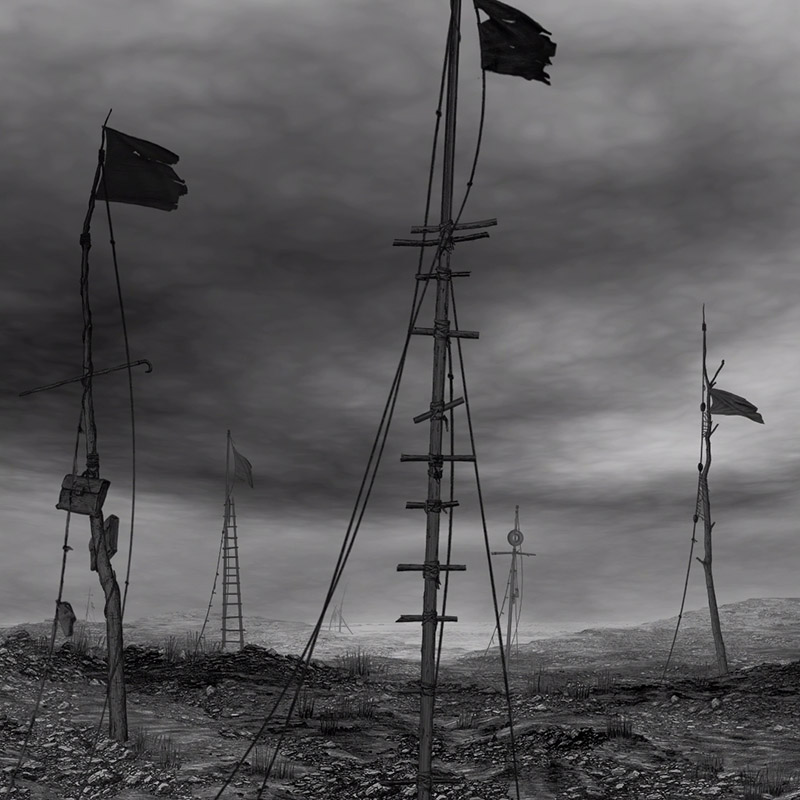There is a sense of relief, upon leaving this exhibition, of being palpably bound up with pavement, sky and, a few short paces away, the murky heave and rush of the Thames with its welcome damp rising. A skeleton hull of a boat, displayed on the banks of the Thames, ghosts the space from which you have emerged.
IC-98 are the Finnish duo, Visa Suonpää and Patrick Söderlund; the moniker an abbreviation of their original name, Iconoclast, from when they first started working together in 1998. Arkhipelagos is their second exhibition at Beaconsfield, following their UK debut in 2012, and comes just as the pair have been announced as their country’s representatives at the 2015 Venice Biennale. The exhibition is composed of two large-screen pencil-drawn animations: Arkhipelagos (Ebb), 2013, serves as a single screen epilogue to the three channel video installation Arkhipelagos (Navigating the Tides of Time), 2013. Each animation is screened in a separate room, dark and empty as the upturned hull of a ship.

Room I:Arkhipelagos (Navigating the Tides of Time), 2013
[20 mins]
The fog of the blank screen clears. The screen gets darker or the contrast increases to reveal hills of rolling water beneath a shifting cloudscape. The first flagpole emerges and the tension begins to build. We are in a dip. Always below the crest of the wave and out of sight of what is ‘over there’. The waves should break over our heads, but they don’t. The waves never break. And we cannot break the surface of the screen to alter or affect their rolling. We have no power over our position. Held hostage by the screen’s supremacy. More masts appear and look as if they will collide but they only gather and bob. The sustained tension of only ever seeing flagpoles with no boats beneath, and the impenetrable solidity of water, is stifling: here is the impossibility of place. Here, we are nowhere. And the remnants of the boats are gathering.
The masts of the boats appear to be an assembly of netting and twigs, crossed by spades, weather vanes and a walking stick. Some have price tags or luggage labels flapping from them, but there is no jangling. Others have what looks like a washing line with clothes pegs or strands of fairy lights unlit, and a ladder. As the flagpole emerges with a climber sprouting leaflets up the mast I’m suddenly homesick for plants, for their humid greenery and oxygen wetness. No wet or wind on skin, hand, face here. The masts are patternless in their wandering, subject to the whims of water and wind. No land to see. It is silent and I am dry and thirsty, longing for a splash or a groan, but there is nothing but the rumble and rush of cars and trains from beyond the gallery to separate fact from fiction. The mist clears. The masts disappear. The screen darkens.
In the cyclical universe that IC-98 have made, the twilight of the Anthropocene period is imagined as at once an end and a beginning. Arkhipelagos heralds the end of human time.
The plant seems to have grown stronger. The light returns, submerging the stars: grey growing white. The bones of boats tantalise, wreck expectation, sealed off by waves that never break. And we remain half drowned with no sense of wet or water, held captive in the dryness of the exhibition space before the solid rolling of the screen, intangible and taunting: a mirage flickering in the arid dark.
Eventually, the mist rolls in to release us and we can fantasise we feel its wet white damp, the oblivion that silences and blinds us to all else. And so the sea dissolves into sky and we are soothed by the blankness of the screen, or the sun shining hopelessly bright in the mist.
There is neither land nor water now. The atoms collide in the air around you. The silence is audible. And then the sails emerge. Your brief moment of respite is over. The darkness of water returns with all the mischief of unfulfilled arrival and absent sense.
I feel exhausted. I have no idea how long the piece is or how long I have been here for. There is a sense of loop, but from which point I am not sure. Yet I cannot relinquish the screen until I am sure it has no secrets left to give. In the cyclical universe that IC-98 have made here, the twilight of the Anthropocene period is imagined as representing at once an end and a beginning (there is something of Noah’s Ark about the plant). Arkhipelagos heralds the end of human time. I, we, the whole gallery, and this work with it, the trains and cars that rattle along outside, will not survive this vision: nature will prevail. We are all out of place, pre- or post-historic.

Room II:Arkhipelagos (Ebb), 2013
[10 mins]
Where did we go that night so dark? And was the light failing or rising?
We are on the other side, now. And there are no boats. The masts are land-bound, earthed, planted. And yet they moved, or we moved round them. Are we on an island now? Were we on a boat? The sea has grown dark beyond this barren ground. We are wrecked, shipless, with the light falling into the black beyond where the ground falls away with no sail to save us. Where we were is far off and confused. And still the clouds move. And still the sea exceeds us. Here we are, on stony ground, no waves to rub between us.
The picture shudders as the trains pass.
It grows dark. It grows dark.
Arkhipelagos is at Beaconsfield Gallery until 7th June 2014.

